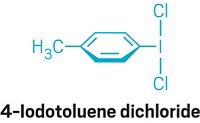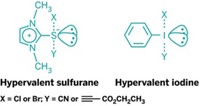Advertisement
Grab your lab coat. Let's get started
Welcome!
Welcome!
Create an account below to get 6 C&EN articles per month, receive newsletters and more - all free.
It seems this is your first time logging in online. Please enter the following information to continue.
As an ACS member you automatically get access to this site. All we need is few more details to create your reading experience.
Not you? Sign in with a different account.
Not you? Sign in with a different account.
ERROR 1
ERROR 1
ERROR 2
ERROR 2
ERROR 2
ERROR 2
ERROR 2
Password and Confirm password must match.
If you have an ACS member number, please enter it here so we can link this account to your membership. (optional)
ERROR 2
ACS values your privacy. By submitting your information, you are gaining access to C&EN and subscribing to our weekly newsletter. We use the information you provide to make your reading experience better, and we will never sell your data to third party members.
Synthesis
A Radical Way To Make Phosphines
Organic Synthesis: Chlorine-free procedure could lead to a green industrial process
by Stephen K. Ritter
August 9, 2010
| A version of this story appeared in
Volume 88, Issue 32

By starting with elemental phosphorus, MIT chemists have developed a radical-based route to versatile organophosphorus compounds that avoids the use of toxic and hard-to-handle chlorine (New J. Chem. 2010, 34, 1533). If the method can be upgraded to a catalytic process and successfully scaled up, it could become a primary industrial route for producing phosphorus compounds.
Phosphorus is at the heart of many chemicals such as pharmaceuticals, fertilizers, and pesticides. Trialkyl- and triarylphosphines used as reagents and catalyst ligands to make these various products are currently prepared by chlorinating white phosphorus (P4) to yield PCl3, which is then treated with a Grignard or lithium reagent or an organohalide with a harsh reducing agent. Chemists have been searching for a way to streamline this synthesis by making phosphines directly from P4 and bypassing Cl2.
Brandi M. Cossairt and Christopher C. Cummins of MIT might have an answer in their general route to PR3 compounds that employs a titanium amide reducing reagent, Ti(NRRʹ)3, where R is tert-butyl and Rʹ is dimethylphenyl. The titanium complex selectively extracts a halogen from an organohalide such as PhBr or CyBr (where Ph is phenyl and Cy is cyclohexyl) to generate carbon-centered radicals that P4 readily traps.
In one experiment, Cossairt and Cummins added PhBr to a mixture of P4 and the titanium amide in benzene solvent. The stoichiometric process generated triphenylphosphine in less than a minute at room temperature, leading to 72% isolated yield. By comparison, the industrial method for making PPh3 involves the high-temperature reaction of PhCl with PCl3 using molten sodium as a reducing agent.
“A chlorine-free process that avoids the use of organometallic reagents would be a highly desirable green approach for large-scale production of phosphorus derivatives,” says Armido Studer of the University of Münster, in Germany, whose group has carried out radical-based organophosphorus chemistry. “This novel process has the potential to become the favored route for large-scale production of PR3 compounds.”





Join the conversation
Contact the reporter
Submit a Letter to the Editor for publication
Engage with us on Twitter